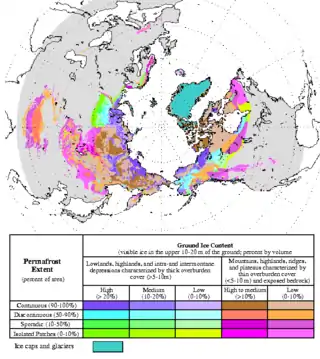Soil carbon feedback
The soil carbon feedback concerns the releases of carbon from soils in response to global warming. This response under climate change is a positive climate feedback. There is approximately two to three times more carbon in global soils than the Earth's atmosphere,[1][2] which makes understanding this feedback crucial to understand future climate change. An increased rate of soil respiration is the main cause of this feedback, where measurements imply that 4 °C of warming increases annual soil respiration by up to 37%.[3]

Soil Carbon Feedback to Climate Change
An observation based study on future climate change, on the soil carbon feedback, conducted since 1991 in Harvard, suggests release of about 190 petagrams of soil carbon, the equivalent of the past two decades of greenhouse gas emissions from fossil fuel burning, until 2100 from the top 1-meter of Earth's soils, due to changes in microbial communities under elevated temperatures.[4][5]
A 2018 study concludes, "Climate-driven losses of soil carbon are currently occurring across many ecosystems, with a detectable and sustained trend emerging at the global scale."[2][6]
Permafrost
Thawing of permafrost (frozen ground), which is located in higher latitudes, the Arctic and sub-Arctic regions, suggest based on observational evidence a linear and chronic release of greenhouse gas emissions with ongoing climate change from these carbon dynamics.[7]
Tipping Point
A study published in 2011 identified a so-called compost-bomb instability, related to a tipping point with explosive soil carbon releases from peatlands. The authors noted that there is a unique stable soil carbon equilibrium for any fixed atmospheric temperature.[8] Despite the prediction that the carbon balance of peatlands is going to shift from a sink to a source this century, peatland ecosystems are still omitted from the main Earth system models and integrated assessment models.[9]
Uncertainties
Climate models do not account for effects of biochemical heat release associated with microbial decomposition.[8]
References
- "Study: Soils Could Release Much More Carbon Than Expected as Climate Warms". Berkeley Lab. March 9, 2017.
- Bond-Lamberty; et al. (2018). "Globally rising soil heterotrophic respiration over recent decades". Nature. 560 (7716): 80–83. doi:10.1038/s41586-018-0358-x. PMID 30068952. S2CID 51893691.
- Caitlin E. Hicks Pries, C. Castanha, R. C. Porras, M. S. Torn (2017). "The whole-soil carbon flux in response to warming". Science. AAAS. 355 (6332): 1420–1423. doi:10.1126/science.aal1319. PMID 28280251. S2CID 206654333.CS1 maint: multiple names: authors list (link)
- "One of the oldest climate change experiments has led to a troubling conclusion". The Washington Post. October 5, 2017.
- Melillo; et al. (2017). "Long-term pattern and magnitude of soil carbon feedback to the climate system in a warming world". Science. AAAS. 358 (6359): 101–105. doi:10.1126/science.aan2874. PMID 28983050.
- "In vicious cycle, warmer soil results in carbon to be released into the atmosphere from the soil, making climate change worse, study says". AP. 2018.
- Schuur; et al. (2014). "Climate change and the permafrost carbon feedback". Nature. 520 (7546): 171–179. doi:10.1038/nature14338. PMID 25855454. S2CID 4460926.
- S. Wieczorek, P. Ashwin, C. M. Luke, P. M. Cox (2011). "Excitability in ramped systems: the compost-bomb instability". Proceedings of the Royal Society A: Mathematical, Physical and Engineering Sciences. The Royal Society. 467 (2129): 1243–1269. doi:10.1098/rspa.2010.0485.CS1 maint: multiple names: authors list (link)
- Loisel, J.; Gallego-Sala, A. V.; Amesbury, M. J.; Magnan, G.; Anshari, G.; Beilman, D. W.; Benavides, J. C.; Blewett, J.; Camill, P.; Charman, D. J.; Chawchai, S. (2020-12-07). "Expert assessment of future vulnerability of the global peatland carbon sink". Nature Climate Change: 1–8. doi:10.1038/s41558-020-00944-0. ISSN 1758-6798.
External links
- Orbiting Carbon Observatory-2 (OCO-2)
- Losses of soil carbon under global warming might equal U.S. emissions Yale University 2016
- Microbial communities Latest Research and Reviews